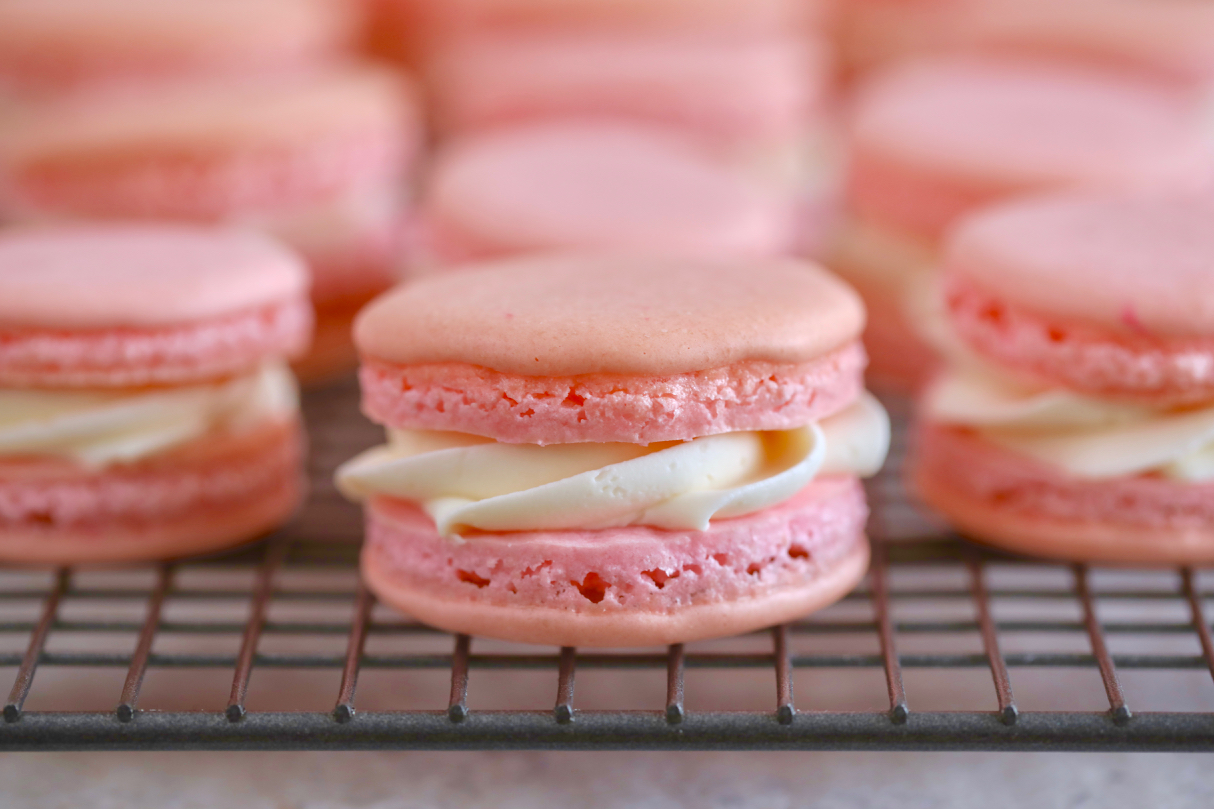
This post may contain affiliate links. Please see my full disclosure for details.
Hi Bold Bakers!
Making French Macarons can leave you in a panic, I get it! It took me a few tries to get the hang of it but I didn’t lose hope and eventually, I nailed it. So, I decided to pass the process onto you and guide you through one of the most notoriously difficult recipes out there, with the simplified methods and steps I follow to ensure perfect macarons with practice, over time.
Plus, I pulled together a list of the 7 Most Common French Macaron Mistakes Everyone Makes and made a video on it to make everything even easier on you!
Below you will learn about what equipment is best, important techniques used in macaron making like ‘rappé’ and ‘macronage’ and the top ‘Tips and Tricks for Macaron Making’. If you are brand new to baking and need to know the basics like how long you need to whip your egg whites, I’ve got you covered.
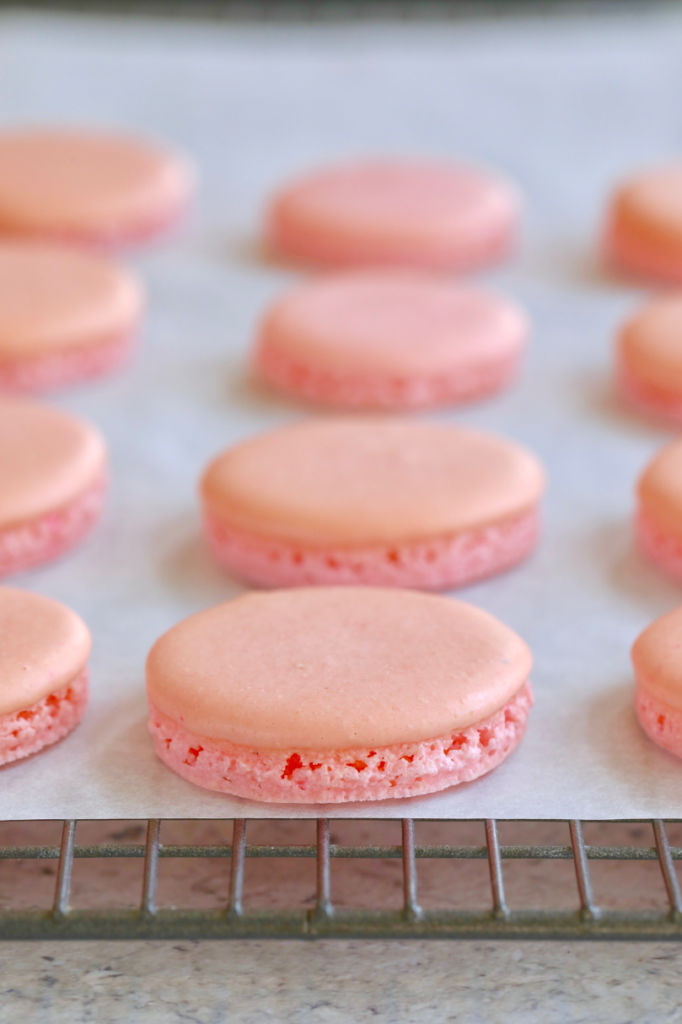
Equipment Needed for Successfully Making French Macarons
- Weighing Scales: Precision is really important when making macarons so I recommend using a weighing scale (standard or digital) as it is more accurate than cup measurements.
- Sieve: It’s important to get your dry ingredients lump-free and aerated and a sieve will do that job
- Hand-Held Electric Mixer: Really useful for whipping up small amounts of egg whites and achieving the peak you want. I swear by my little hand mixer.
- Metal Spoon: It’s a traditional method and best practice that when folding a mix of whipped eggs that you use a thin-edged, metal spoon to do the folding. The thin edge will slice through the mix incorporating the other ingredients WITHOUT knocking out all that lovely air you achieved in the previous step. A spatula is too thick and can knock out the air.
- Double Trays: Macarons are very delicate so I recommend stacking two baking trays on top of each other to bake on. This just protects them incase your oven happens to be quite hot on the bottom. We want to bake macarons careful with little to no browning.
- Piping bag and Nozzle: For a more uniformed look to your macarons you will need to pipe them on the tray with a piping bag fitted with a nozzle. Don’t start making macarons without a piping bag to hand as this step is a MUST!
How to Make French Macarons
When it comes to making this recipe, following the steps is a must. Here’s a quick look at all the things you must do!
- First, you need to make sure your dry ingredients are sifted together and lump-free.
- Then, you need to whip your egg whites into meringue. Here’s a guide on how long you should whip them if you need it.
- After that, you need to sift the dry ingredients into your meringue. This is when you add your food coloring, too.
- Gently fold your sifted ingredients into the meringue with a thin-edged spoon.
- Transfer to a piping bag.
- Pipe your batter into circles using the Bigger Bolder Baking template.
- Gently tap your baking sheet to release possible air bubbles.
- Let your piped macarons sit until they develop a skin.
- Bake them at 300° for 15-20 minutes.
- Let your macarons cool before sandwiching your filling between them!
A lot can go wrong with so many steps so let me do my best to help you avoid as much heartbreak as I can!
Here Are The 7 Most Common French Macarons Mistakes And How to Get Past Them:
1. Cracked Macarons
There are a few reasons why the tops of macarons crack. Under mixing could result in too much air in the batter and, while they are baking, the air bubbles expand in the oven and crack the tops. This is another reason why it is important to tap your pans (rappé) after piping the macarons, to remove any extra air bubbles.
Another reason for cracking would be if they didn’t rest long enough to develop a proper skin. The longer you rest the macarons, the thicker the skin that develops. When baking, if the skin is too thin, the heat could burst through and crack the tops. Proper skin development ensures that when baking the heat pushes downwards (to create the feet) rather than upwards (which could crack the tops).
2. My French Macarons Don’t Have Feet
The main reason would be that the batter is too wet and runny. That is due to a few things: the meringue wasn’t dry enough when folded in, it’s a humid environment and/or the batter was overmixed. The viscosity of the batter is very crucial to ensure proper macaron making. Remember, you want that lava-like quality.
[ Struggling with making bread, too? Find out what the 7 Most Common Breadmaking Mistakes are! ]
3. My Macarons Are Flat
Overmixing can result in flat macarons. After the dry ingredients and meringue are fully incorporated, macronage is the folding technique that ensures the proper batter consistency. Slowly fold the mixture using a thin metal spoon until it loosens a little and becomes smooth.
When properly done, the batter should be shiny and flow like lava off the spoon. To test the consistency, gently lift some batter over itself in a slow stream. Once the ribbon of batter disappears into itself after 15 to 30 seconds then you’re ready to pipe. Do not overmix because deflating all the air will result in sad macarons. It takes practice to get this technique right.
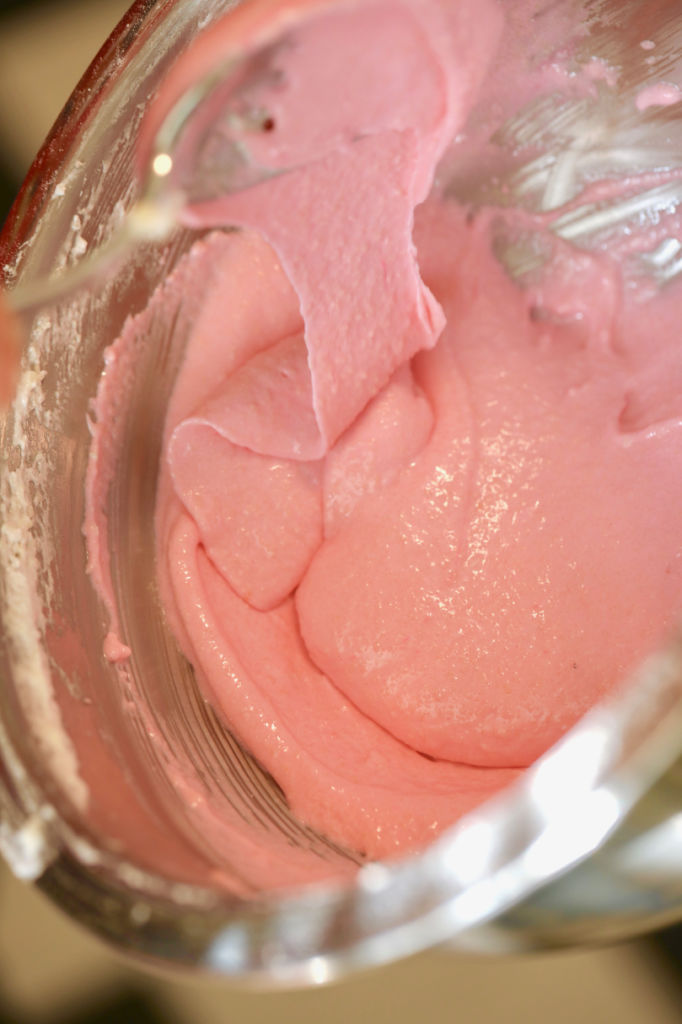
4. Not Drying Your Macarons
Leave your shells in a dry area to dry, so that when you press the surface it is dry and not sticky.
Resting the piped macarons allows for skin to develop on top of the cookies. Resting time can range anywhere from 30 to 60 minutes depending on your kitchen. You’ll know your macarons are ready to bake when you lightly press the surface and it’s dry and not sticky. After resting, they should look matte and not shiny like when you first piped them.
The “skin” helps create that hardened shell that’s iconic of the macaron. Also, without proper “skin” development, when baking, the heat will escape from the top rather than from the bottom which creates the other iconic feature of the macaron — the “feet”.
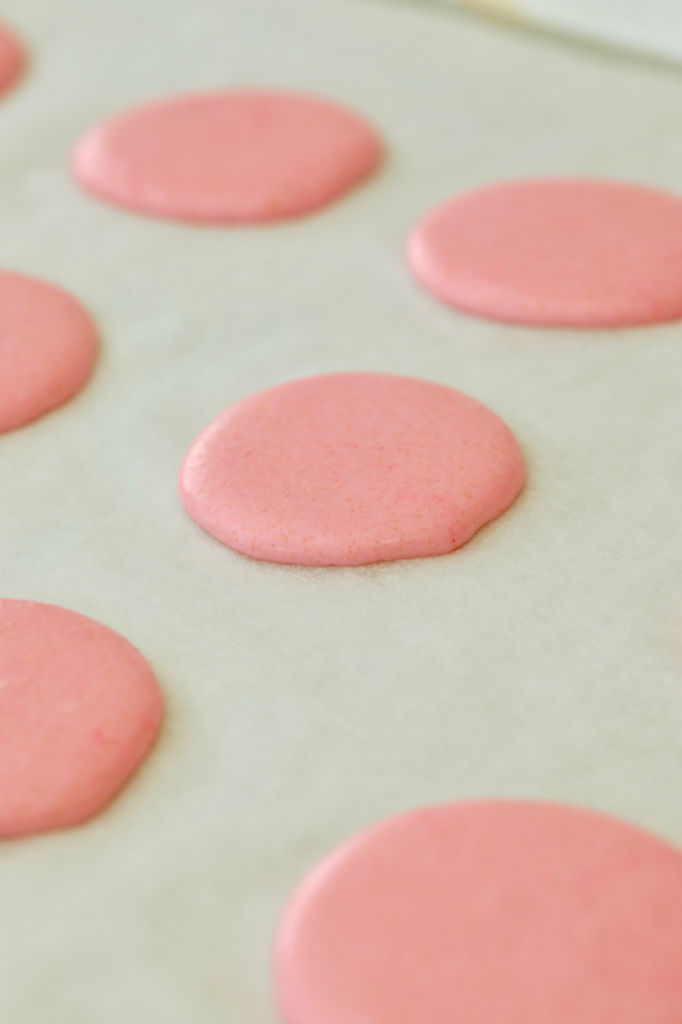
5. Making Macarons When It’s Humid
Although possible, it would be rather difficult to bake macarons in a humid environment. Humidity is macaron’s enemy. If the environment is humid, it can affect the resting stage, resulting in no “skin” and therefore no hardened shell of the macaron when baked. Humidity can even affect the moisture in the meringue so it might be hard to whip super-stiff egg whites.
Perhaps use a dehumidifier in the room when you are baking macarons during a rainy or humid day if you must!
6. Hollow Macarons
This can happen for a few reasons, like overbeaten egg whites at the beginning can result in hollow macaron shells. Also, shells resting for too long during the drying period can result in hollow macarons. A 40-60 minutes resting period is usually enough.
Lastly, the oven temperature set too high can prevent the insides to set, causing the meringue to collapse when the shells are taken out of the oven.
7. Uneven Feet
Your oven temperature is possibly too high. It’s best to bake at a lower temperature (285 to 315°F [140 to 160°C], depending on your oven) for a longer period of time so that the shells rise slowly but consistently.
Some ovens have poor air circulation, making the temperature rise excessively, so it may help to keep the oven door slightly open (with the help of a wooden spoon) throughout the cooking process. Also, you can double pan when you bake as this step helps ensure even heat distribution, thus level feet on the bottoms of your cookies.
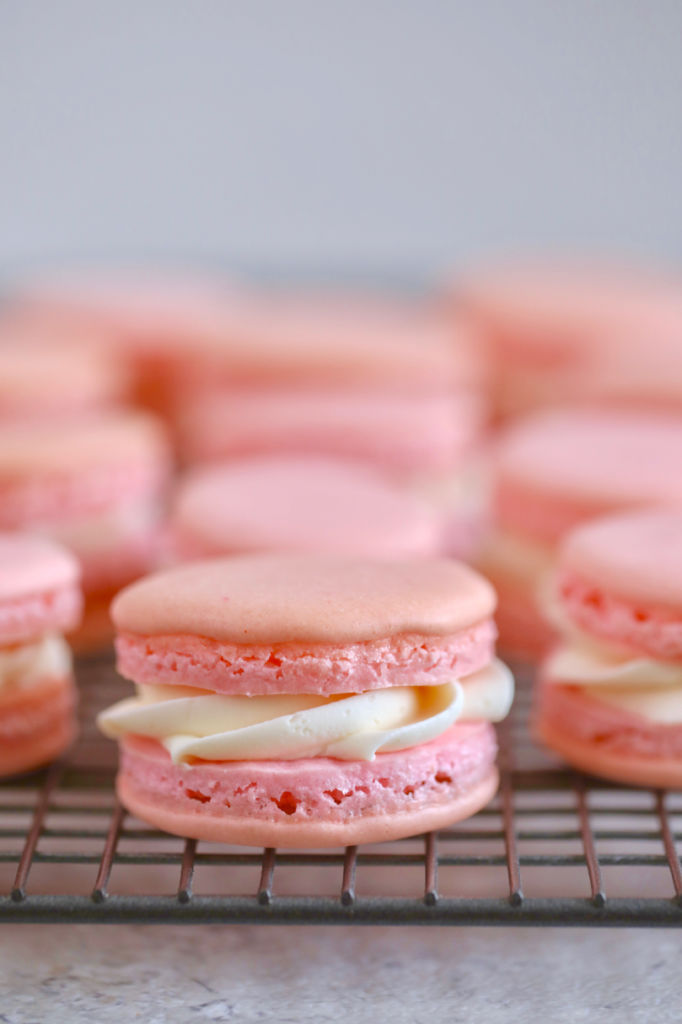
More Tips & Tricks for Making Macarons:
- Double pan when you bake: It helps ensure even heat distribution, thus level feet on the bottoms of your cookies.
- Mature the cookies with the filling for at least overnight: This will allow them to soften for a more mellow texture and more developed flavor.
- Better to undermix than overmix during macronaging: If the batter is overmixed, it will be too runny to pipe, the tops will most likely crack and no feet will develop.
- Humidity is macaron’s enemy: If the environment is humid, it can affect the resting stage, resulting in no “skin” and therefore no hardened shell of the macaron when baked. Humidity can even affect the moisture in the meringue so it might be hard to whip super-stiff egg whites.
- Aging egg whites for meringue. Leave egg whites at room temp for 24 hours before making your batter. Room temperature egg whites will make it easier to whip up a stiffer and drier meringue. Aging whites also dehydrates them and will hopefully result in a less runny batter.
- Use powdered or concentrated gel food coloring when coloring macarons. You don’t want to add a watery dye to your batter as it can change the texture of your French Macarons.
- Gently tap your baking sheets on your benchtop to remove any extra bubbles from your piped shells. Rappé is the macaron technique that requires you to tap your sheets of piped macarons before its final resting phase. The tapping motion ensures that any leftover air bubbles escape from the batter. If there are air pockets in your batter while it bakes, it may result in the tops of the cookies cracking.
- Sift dry ingredients. Work the small lumps through the sieve with your fingers. Set aside the almonds that don’t pass through for another recipe. Sifting the almond meal and powdered sugar ensures that no large chunks of almond appear in your batter which could weigh it down. Sifting also aerates the dry ingredients which help with the airy quality of the final product.
- When are macarons done? To test whether macarons are done baking, gently touch the feet of the cookie. If they are still sticky then they need more time. Bake until the feet are set and do not shift when lightly touched.
- Always store macarons in an airtight container. The filled French Macarons can be stored in the fridge for 4 days.
Make Some of My Other Favorite Macarons!
If you want to try more macarons, make sure you try my:
Download the Template!
Don’t forget to follow Bigger Bolder Baking on Pinterest!
Watch The Recipe Video!
French Macarons Recipe
Ingredients
- 55 grams almond flour (aka ground almonds/ almond meal)
- 100 grams powdered sugar
- 50 grams egg whites , room temperature
- 25 grams granulated sugar
- Gel Food coloring , optional
- Buttercream Frosting
Instructions
- In a small bowl, sift together the almond meal and powdered sugar. Remove any almond lumps if necessary.
- In a medium bowl, using a stand mixer or an electric hand mixer, whip the eggs until frothy.
- Using a stand mixer fitted with the whisk attachment, or a handheld electric mixer, whisk the egg whites on low speed for about 2 minutes, until they start to thicken.
- With the mixer running, gradually add the granulated sugar, 2 teaspoons at a time, and beat until the meringue is stiff and shiny. Once all the sugar has been added, whip for 2 minutes more or until stiff peaks.
- Re-sift the dry ingredients over the meringue. If using food coloring, add in at this time. Fold it in very gently with a thin-edged spoon until no dry streaks remain.
- Once the batter is homogenous, continue to gently fold until shiny and the texture resembles slow-flowing lava off the spoon. To test the consistency, gently lift some batter over itself in a slow stream. Once the ribbon of batter disappears into itself after 15 to 30 seconds then you’re ready to pipe.
- Transfer the batter to a piping bag fitted with a medium round tip. If using, place your macaron stencil on a thick-bottomed baking sheet and lay parchment paper over it. Otherwise, on a parchment-lined baking sheet, pipe macarons at least 1 ½” apart from each other. Gently tap your baking sheets on your countertop to remove any air bubbles from the piped macarons.
- Rest the shells uncovered in a dry area for about an hour or until a “skin” develops on the top of the cookies, roughly 40-60 minutes. You’ll know your cookies are ready to bake when you lightly press the surface and it’s dry and not sticky. They should look matte and not shiny like when you first piped them.
- Preheat the oven to 300°F (150°C). Place a second baking sheet underneath your piped cookie sheets. Double panning helps ensure even heat distribution, therefore leveled feet on your macarons.
- Bake for roughly 15-20 minutes or until the feet are dry and not sticky when gently touched.
- Remove from the oven and cool on the baking sheet for a few minutes. Transfer the entire sheet of parchment on a wire rack to cool completely. Gently peel the cookies from the parchment. (if your macarons seem a little wet pop them into the oven with the door open to dry out a little longer.
- Pipe or dollop the buttercream onto one shell and top with a matching sized shell. Place in an airtight container and allow filled macarons to mature in the fridge overnight.
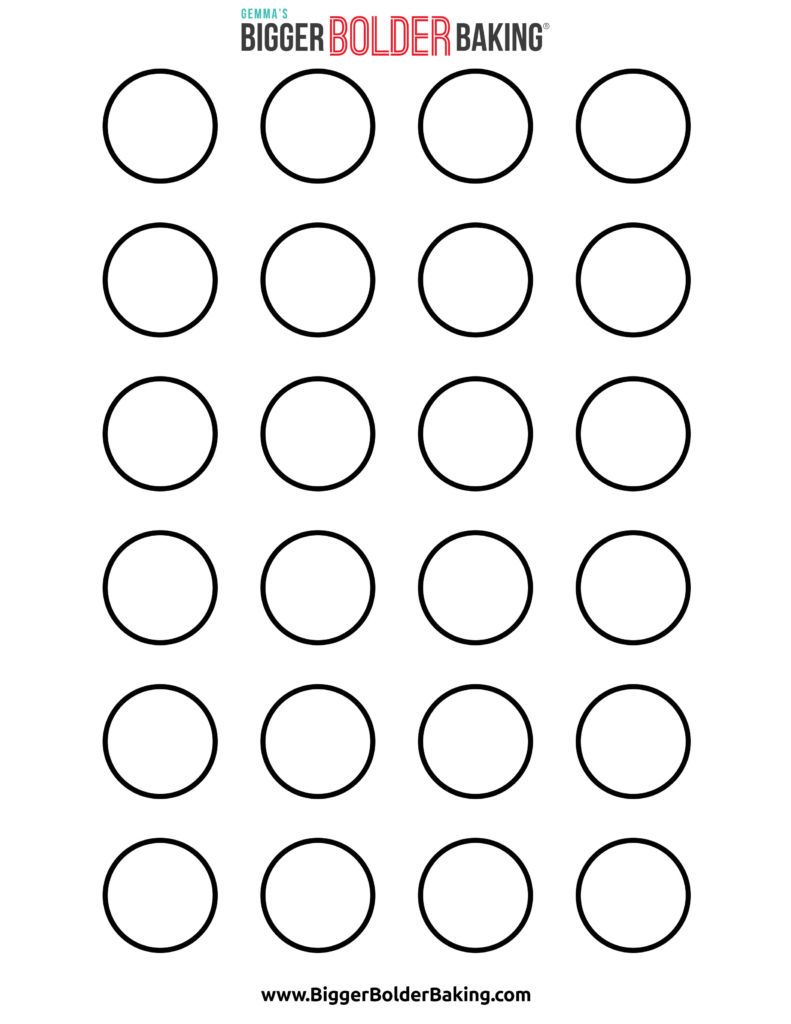

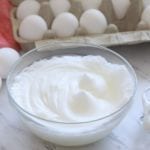




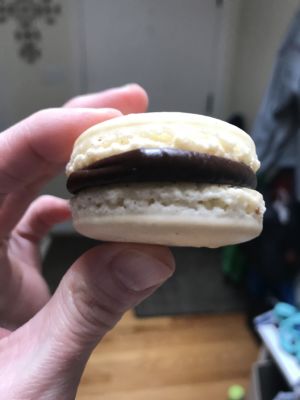
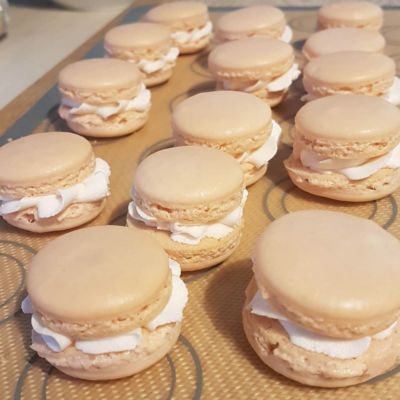
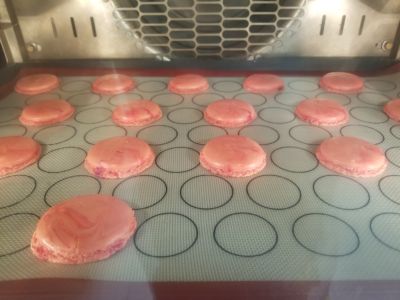
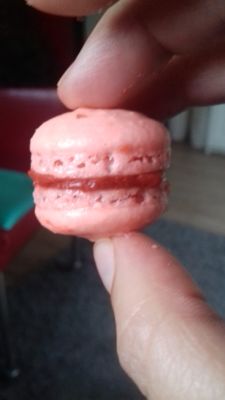
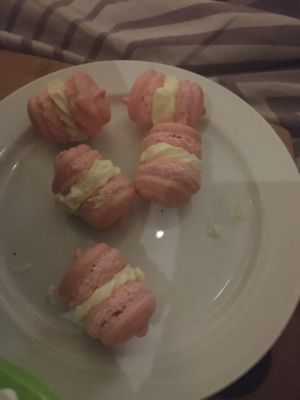
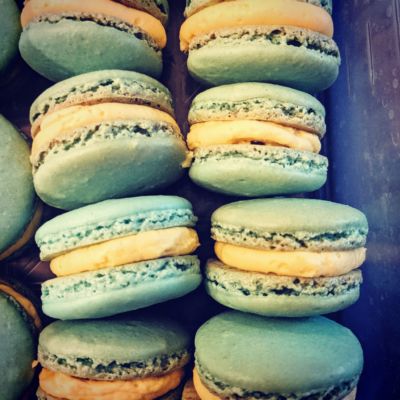
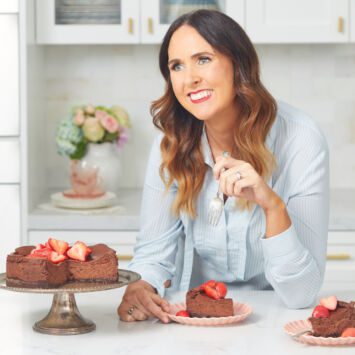

My macarons came out beautifully! Since we’re in quarantine for now, I figured I could try making things I haven’t yet. Macarons, my favorite treat, was top of the list. And these came out wonderfully with no cracks and and good feet.
I also used the crazy buttercream recipe to make a lemon buttercream for the filling!
Yummy! I will try this but can you convert to cups/tablespoons for me? thankx
Hi Gemma. Thank you for sharing the recipe. I am waiting for my white to age in the fridge. Can I use homemade powdered sugar with your recipe for this recipe?
Hi Gemma. You’ve given me the courage to try baking again. Thank you for that!
If I make these, can I use an airbag pan instead of layering my pans? I think that will do the same thing for me.
Thanks again and all the best!
I made macarons once before a few months ago and it failed, I tried it again today this time with this recipe and it was a succes! I’m so happy! 🙂
Hey, van you make macarons without sugar? And use sugar substitute ( zusto)?
My mom dont want me to use sugar , so yeah….😐😑😒, Thanks
Hi Gemma,
I was wondering, do you have any alternatives to using almond flour for nut allergies?
Thank you!
Hey there Gemma,
I have all of your books. You are with out a doubt the most clear headed common sense knowledgeable baking instructo
“ out “ there. KUDOS to you, your husband and the staff.
If ever down here, University of Florida, in Beautiful North Central Florida, Gainesville, Florida; say hey.
Respectfully,
Cosmo Topper
These turned out PERFECT! Thank you so much for this recipe and video tutorial Gemma!
Hi Gemma, I’m so excited to try making these! I’ve printed off the circle template but they seem kinda smaller than the ones in the video…..what should the diameter of each circle end up being?